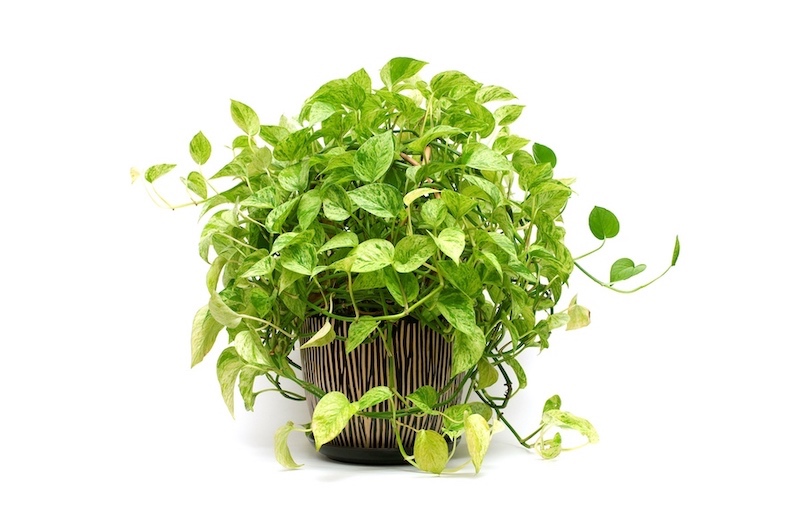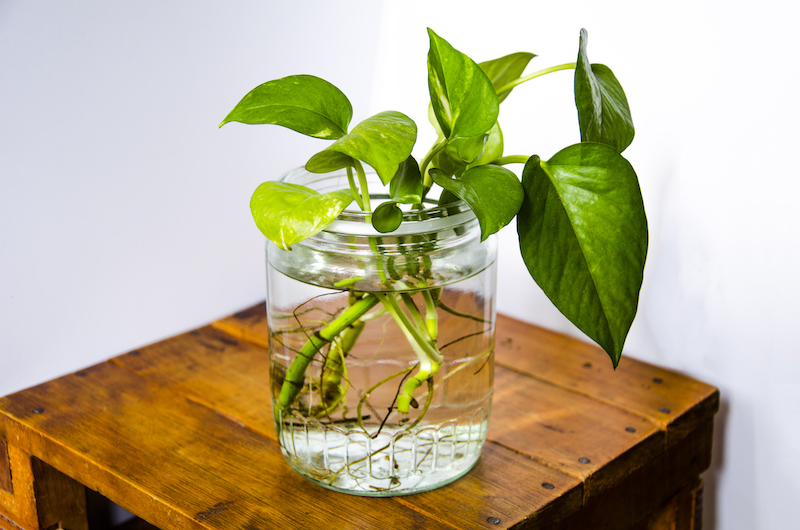If you are looking for a truly hardy, easy-to-grow indoor plant, you’ll find the pothos (Epipremnum) care is simple. Pothos plants can be grown as trailing vines or can be kept more compact by regular pruning. They will grow in bright, indirect light but are also adaptable to low light conditions and will even grow well under fluorescent lighting, making them a great choice for office environments. Different varieties of pothos have leaves ranging in colour from variegated leaves to stunning bright ‘neon’ green leaves.

 |
 |
 |
 |
| Light | Water | Ease of Growing | Growth Rate |
| Range of light conditions. Avoid direct sunlight. | Underwatering is better than overwatering. | Very easy, great for beginners. | Fast in right conditions. |
Pothos (Epipremnum) Care Guide
Light
For the more common pothos (Epipremnum) care is simple and the plants can be grown in a variety of light levels. They will grow fastest in a spot with bright to moderate light, although they can adapt to lower light levels as well. The important thing is to avoid direct sunlight.
The golden pothos will usually keep its leaf variegation in lower light levels which is not common. Usually, the colour of variegated leaves will fade in lower light. These plants can also grow under fluorescent light which makes them ideal for office environments.
Water
With pothos (Epipremnum) care, overwatering is more of a problem than underwatering. It is advisable to allow the soil surface to dry out between waterings and drain away any excess after watering.
During the growing season they require more water however during winter a lot less water is needed and they can be particularly at risk of root rot if given too much water. They don’t like to be in soggy soil.
Temperature
For ideal pothos growth (Epipremnum) care requires a warm environment with temperatures above 50ºF (10ºC) in winter. Ideal conditions are between 59ºF – 77ºF (15ºC – 25ºC) and cold drafts should be avoided.
Humidity
An easy care plant, the pothos is not particulary demanding of specific humidity levels. It prefers higher humidity but the air would have to be quite dry to cause problems. Brown leaf tips would be an indicator of the humidity being too low.
Fertilizer
Fertilizer is only required during the growing season of spring to summer. A weak liquid fertilizer can be given once every month or two to encourage healthy, lush growth if the soil needs enriching.
Pruning
For a beautiful, lush pothos (Epipremnum) care does involve pruning. Pruning a pothos allows you to shape the pothos to grow draped along a shelf, on a moss pole or trailing from a hanging basket. Minimal pruning will result in a vine that trails. For a more compact, bushy plant, prune just above the leaf nodes and this will encourage the plant to branch out.
If your pothos gets really long and out of control sometimes the lower, older leaves will yellow and drop off which can result in a plant the looks a bit bare. If this happens you can cut the vine right back, just above a node, which should encourage new growth.
The benefit of pruning is that the cuttings can be propagated for a new collection of pothos plants. Spread your pothos around home or give away to friends and family. More on this below.
Cast Iron Plant Care Planting Guide
Soil
Well-draining soil is important for your pothos as they are susceptible to root rot if overwatered. If you have some coco coir or perlite this can be added to soil to improve the drainage.
Repotting
For the best Epipremnum care, your pothos will only need to be repotted every couple of years when the plant is quite root bound. The plant and roots can be trimmed and the same size pot used, with fresh soil. Always use a pot with good drainage.
Propagation
Pothos are one of the easiest plants to propagate and have a very high success rate. The best time of year to propagate is in spring or summer and if you time this with pruning your plant you will have plenty of cuttings to grow. Choose a healthy plant with healthy leaves and take a stem cutting 4″ – 6″ (10cm – 15cm), just below a node.
The stem cutting can either be placed directly in soil, or in water, for roots to grow.
A cutting in water will grow roots within a few weeks. Pothos plants can be left to grow in water quite happily. Simply change the water every week or so and be sure that only the roots are submerged. Keep the stems above the water. You’ll find this to be a very low maintenance Epipremnum care technique.
A cutting that has grown roots in water can also be planted. Once the cutting has some roots, and before they get longer than a couple of inches, the cutting can be planted in soil. The way to do this is similar to how you would plant a stem cutting. Care needs to be taken initially to ensure the soil is kept moist and the plant should be placed in a spot with low to moderate light. Once it is well-established, watering can be reduced to the recommended amounts described above. Changing plants from soil to water and water to soil, can be a bit tricky and this may be when your Epipremnum care is the most intense.
Common Pothos, Epipremnum Care Problems

Despite your best efforts to provide the ideal growing environment, pothos (Epipremnum) care, does require you to get to know your plants and observe how they are growing. At times they may experience some problems but because pothos plants are generally fairly hardy they will usually bounce back, except perhaps from overwatering.
Pothos plants do not like being in soggy, waterlogged soil. Overwatering can result in root rot which will eventually lead to the death of your plant if it is left unmanaged. Signs of root rot could be yellowing leaves, black, mushy spots on leaves, or leaves near the base falling off. Leave your plant to dry out a little. It may be necessary to repot it with fresh soil to encourage new root growth. A soil moisture meter can be helpful if you are having trouble getting the balance of water right.
Leaves that have dry, brown, crunchy leaf edges or tips may be caused by underwatering. Adjust your watering levels to be more regular and remember it is only the surface of the soil that needs to be slightly dry between waterings.
Too much light can damage the leaves resulting in scorch marks or the leaves can become translucent.
Too little light may result in slower growth and some pothos varieties may lose their colour variegation in the leaves.
Toxicity
Pothos plants have a sap in the stems and leaves which can be mildly toxic to people and pets. The sap can cause a painful, burning sensation in the mouth and can cause intestinal upset if large quantities are ingested.
Summary Of Cast Iron Plant Care
Do:
- let the soil surface dry out between waterings
- prune to keep it more compact and bushy
- try propagating it
Don’t:
- place it in direct sunlight
- overwater it
Interesting Facts
- Pothos plants are great at purifying the air and removing toxins.
- In Europe they are known by the name Scindapsus.
Pothos plants provide beautiful, lush foliage, are adaptable to many growing conditions in your home and provide a variety of growth forms so there is surely room for at least one of these plants in your home. Whether you desire to have the vines trailing down, reaching out across a bookshelf or you wish to keep it compact climbing on a moss pole, you will find our pothos, Epipremnum care guide to have all the tips you need.










